Trip
to Ireland, Scotland and Guernsey with Ryan 2012
(Click on pictures and high-lighted text for larger images)
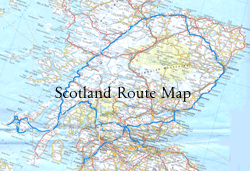
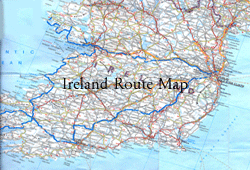
Ireland is the place of rugged coastlines, ruins and breweries, Scotland
of rolling hills, castles and distilleries and Guernsey of tranquil laneways,
coastal bays and fine wines. What better places to go with my son Ryan
who had a year off from teaching, a 4 over 5 form of sabbatical in which
he received 80% of his salary for 4 years and then has the fifth year
off with 80% pay – not bad. His plan had been to visit every continent,
including Antarctica, and by April he had covered every one but Asia.
Since I have less interest in joining him there, we agreed that we would
meet in England and explore Ireland, Scotland and Guernsey before he took
off to Bangkok.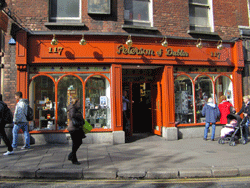
So, on April 18th, I flew from Toronto to Gatwick via Air Transat and
met him in the Costa Coffee restaurant at the airport; he had flown into
England the day before as part of his around the world ticket. From there
we flew on to Dublin via Aer Lingus and ‘Aircoach’-ed our
way into Dublin, checking into the Best Western Plus 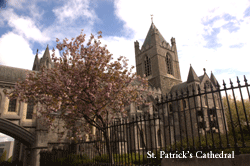 Academy
Plaza Hotel on Findlater Place, a good location for exploring Dublin on
foot.
Academy
Plaza Hotel on Findlater Place, a good location for exploring Dublin on
foot.
Settled in, we walked to Grafton St., the main shopping street of Dublin,
making a special visit to Peterson Pipe store where I would buy a pipe
the next day. After a snack of natchos (very Irish) we went to St Patrick’s
Cathedral for a quiet choral evensong before a walk through Temple Bar
and a dinner of Irish stew and a pint of Guinness.
The next morning, after breakfast in the hotel, we ambled over to the
Guinness Brewery Storehouse at St. James's Gate. To me it was a disappointingly
commercial exhibition in a converted part of the old brewery, offering
a series of displays on the beer making process but with no real beer
until the sampling room. Guinness is not how I remember it with its delicious
molasses taste. It seems to have been remodeled for the mass demand. Also
the company has been taken over by Diageo, a global company that is buying
out breweries, distilleries and wineries and making them more efficient
(more later).
From there we walked to the old jail and then grabbed a taxi (it had started
to shower) to Trinity College which was closed as the quad was being set
up for a student event. Disappointed by our bad luck, we walked to St.
Stephens Green and visited the Little Museum of Dublin, a great truly
‘little’ museum which tells the story of Ireland’s capital
city in the 20th Century. Then it was off to a dinner of fish and chips
at Hairy Lemon (a take-off on Harry Lime) in the Temple Bar.
---
The next morning, after a quick trip back to Trinity College (now open)
to see the Book of Kells (or more accurately, two pages of the book),
it was back to the airport to pick up the car and get on our way to Galway.
We were told that one hubcap was not tied on but we didn’t understand
the importance until, speeding along the M1 at 120 mph, it went flying
off; we know not where. The other three were still tied on but flapping
like birds’ wings as the wheels rotated. After one further attempt
to secure them unsuccessfully, we cut the ties and stored them in the
trunk. When we returned the car a week later, the agent only comment was:
“guess you had trouble with the hub caps.”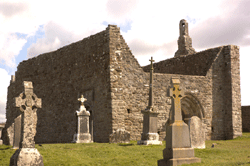
On our way again, we detoured to the ancient monastery of Clonmacnoise
founded by St. Ciarán in the mid-6th century on the eastern bank
of the River Shannon. The site includes the ruins of a cathedral, seven
churches (10th -13th century), two round towers, three high crosses and
the largest collection of Early Christian grave slabs in Western Europe.
Then it was onto Atlantic View B&B in Salthill, a coastal suburb of
Galway from where we walked along Galway Bay to town for supper at the
Quay – Oysters and a seafood platter.
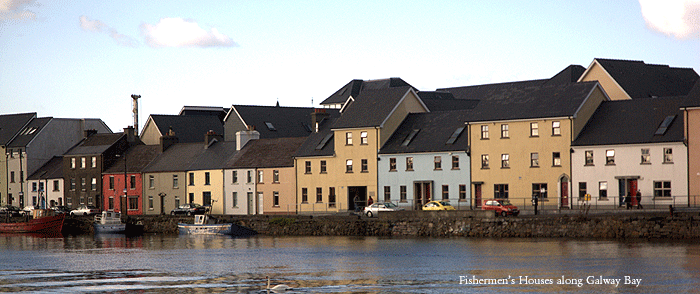
---
Waking up to sun, I took off on my morning walk along the shore overlooking
Galway Bay before breakfast. Then it was off to meet Lynda
and Alan Cookson, a distant cousin, for a pub lunch in Barna and a
guided tour along the coast, with its wandering stone
walls, peat piles,
horses, curious
donkeys and sheep
before heading into the hills of Connemara.
After a stop for tea we headed west to Clifden for the night
at The Quay hotel on the shore
of the inlet, where Alcock and Brown landed in a modified Vimy IV, after
making the first non-stop aerial crossing of the Atlantic. They had taken
off from Lester's Field, near St. Johns, Newfoundland on June 14, 1919
and sixteen hours, twenty-seven minutes later, landed June 15, 1919, at
Clifden.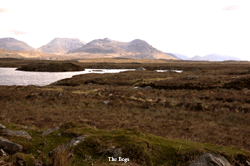
After another early sunrise
walk the next morning along the coast and a breakfast of fresh haddock
and poached eggs, we headed off through the bogs where one step off the
road and you can sink to yours knees and on to 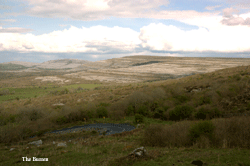 Roundstone
and then Oughterard for a pub lunch.
Roundstone
and then Oughterard for a pub lunch.
Once past Galway we headed through the Burren, one of the largest karst
landscapes in Europe. Karst, we learned, is a unique and somewhat barren
landscape formed by the underground erosion of rocks such as limestone
and marble that dissolve in water leaving cracks and caves.
Then it was on to the spectacular Cliffs of Moher which are “one of Ireland's top Visitor attractions and are a designated UNESCO Geo Park. The Cliffs are 214m high at the highest point and range for 8 kilometres over the Atlantic Ocean on the western seaboard of County Clare.”
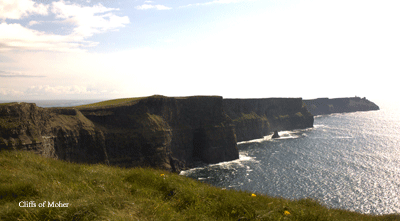

Finally it was on to Kilrush where we stayed at the Hillcrest View B&B
with supper at Grotty’s. On the way, we were detoured off the main
road by a fireman who explained that the road ahead was blocked by and
overturned camper. He explained that we had to take a small lane around
the accident but what he either did not know or ignored was that oncoming
traffic was also being rerouted on the same road which made passing extremely
difficult.
---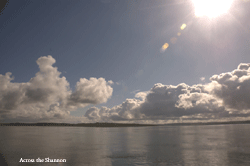
24/4
The next morning we were up early to catch the car ferry across the Shannon
and off to Killarney where we found a room at the Crystal Springs B&B
on the outskirts of town.
And then began our drive of the Ring of Kerry which we estimated would
take few hours but, with stops, it was a six hour excursion. Our first
stop was in Cahersiveen, birthplace of Daniel O'Connell, 'The Liberator
of Ireland', for lunch and the nearby Ballycarbery Castle and two ancient
Stone Ring Forts.
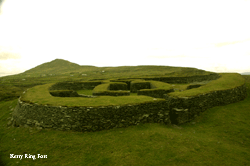
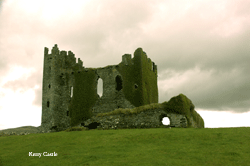

Onwards to the west was a walk to the cliffs of Kerry but these were a
poor comparison to those of Moher and finally a picturesque drive along
the south shore.
Tired and hungry we found supper at the Laurel and had one of the best
meals of the trip of kidneys and fresh crab before listening to traditional
Celtic music at the Grande.
---
 25/4
25/4
The next morning we woke disappointedly to cloud and showers
but that didn’t affect our plans to visit Ross Castle and Torq Falls
on the edge of Lough Leane, in Killarney National Park, and then drive
through Macroon and finally to Cork where we got a room at Auburn House
in the heart of the town. We rewarded ourselves with supper at the Market
Place – monkfish and aubergine with red wine for a change.
---
26/4
After a light breakfast on MacCurtain Street the next morning, we visited
the Cork City Gaol opened in 1824 & reported to be "the finest
in 3 Kingdoms".
 Then it was on to Blarney Castle famous for its legendary Stone of Eloquence,
found at the top of our Tower. The claim is that if you kiss it you'll
never again be lost for words. Ryan gave it a go and the result was immediate.
(I had done that on a previous visit and once is supposed to last a lifetime.)
Then it was on to Blarney Castle famous for its legendary Stone of Eloquence,
found at the top of our Tower. The claim is that if you kiss it you'll
never again be lost for words. Ryan gave it a go and the result was immediate.
(I had done that on a previous visit and once is supposed to last a lifetime.)
Then it was off to the Rock of Cashel, also known as Cashel of the Kings
and St. Patrick's Rock, which is reputed to be the site of the conversion
of the King of Munster by St. Patrick in the 5th century. Now it stands
in partial ruin.
The day ended in Kilkenny, with us staying at Butler Court (with Yvonne
and Bob The Dog) in the heart of town. Supper was found at the Market
City Restaurant -seafood chowder and beef and Guinness pie followed by
more ‘trad’ music at Ryan’s pub.
---
27/4
Kilkenny is less than a two hour drive from Dublin Airport, where we had
to be at the end of the next day, so we decided to spend most of the day
in town. First on our list was to make a reservation for a brewery tour
at Smithwick’s for the afternoon. Then it was on to the Castle built
in 1195 by William Marshal. It was a symbol of Norman occupation and in
its original thirteenth-century condition it would have formed an important
element of the defences of the town with four large circular corner towers
and a massive ditch, part of which can still be seen today. It remained
in the Butler family until 1967 but they could no longer afford to maintain
it so much of the furnishing had been sold off in the early 1900s and
the building was alowed to sink into disrepair. Now reconstructed, I was
not impressed.

Next it was The Cathedral Church of St Canice 1202-1285. Of interest was
the grave of Bishop John Kearney who was the provost of Trinity college
Dublin in1799, Bishop in Kilkenny 1806-1813, and a great-great grand uncle
of Barrack Obama. Its Round Tower built in 849, which may once have been
both a watchtower and a refuge, is the oldest standing structure in Kilkenny
City. It has 7 steep sets of internal ladders which we climbed up to the
top.
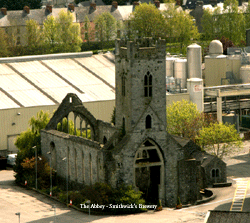
After lunch of whiting and chips at Bollards, it was time for Smithwick's
Brewery. This 300 year old brewery is situated in the heart of the town
on land which was once the site of an ancient monastery. Back in the 13th
century, The Franciscans established St. Francis Abbey, with its own well,
on the banks of the River Nore in Kilkenny. In 1710, John Smithwick began
brewing his first Ales on the same land using water from St. Francis'
Well. Sadly, the brewery is to be closed in 2013 as Diageo, the new owners,
plan to move production closer to Dublin. Supposedly the water is to be
shipped in tanker trucks but who knows how long that will last once economic
factors get into play. Evidence of global decision making is already apparent
in the “new” brew they have introduced – Pale Ale –
which we sampled to our disappointment.
---
28/4
Dropping off the car, less its one hub cap, we were then off to catch
our flight to Prestwick near Glasgow via Ryanair. We had checked in online
the day before but we had no way to print boarding passes so we arrived
at the check in to get them only to be told that we would have to go to
a ticket counter to purchase them. There we learned that each pass would
cost us 60 Euros. DON’T EVER FLY RYANAIR!!!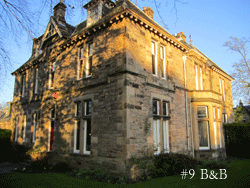
At Prestwick we picked up another rental car and drove northeast to Stirling
where we found a character B&B in the old established Kings Park area
of town - #9 - operated by Mrs Brodie, a gracious cross-eyed woman.
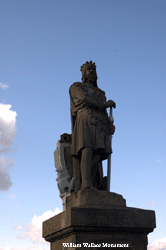
A short drive got us to The National Wallace Monument on a hill overlooking
the scene of Scotland’s victory at The Battle of Stirling Bridge.
At this battle, in 1297, Scotland was led to victory by William
Wallace. Wallace, “a hero of Scotland and a true patriot, had
a burning desire for peace and freedom which united the country’s
clans, gained the loyalty of its people, struck fear into his enemies
and defied the cruel hand of an evil, warring and invading King - Edward
I of England.” Again we climbed the 200+ circular stone stairs to
the top of the tower with its view of Ben Lomond and The Trossachs in
the West to The Pentland Hills in the East.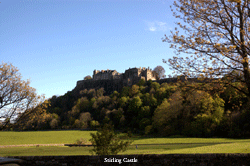
Back on terra firma and in town, it was time for a snack and good Scottish
beer - as good as any we found in Ireland.
Stirling Castle is a well restored gem, “a great symbol of Scottish
independence & a source of national pride. Knights, nobles and foreign
ambassadors once flocked to the Royal Court at Stirling Castle to revel
in the castle's grandeur.” A walk through town and it was time for
a pub supper of haggis rolled in chicken breast and baked with Scottish
beer.
----
29/4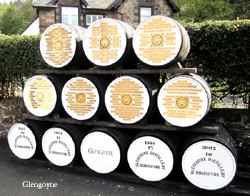
Next morning it was off south to Glengoyne distillery in the sunshine
for the Wee Tasting Tour concluding with a sampling of their 10 year old
plus their award winning Glengoyne 17 year old Highland Single Malt Whisky.
Not bad for “a morning’s work.”
A peek at Loch Lomond, the lake with such romantic connections -
‘me and my true love will never meet again on the bonnie, bonnie
banks o' Loch Lomond”
left us empty. It is no different or prettier than most Muskoka lakes
and crowded with its own tourists.
As we drove northeast to St. Andrews over the Highland Boundary Fault,
the divider between the lowlands of Central Scotland and the Highlands,
the sky became cloudy and windy. For amusement, we played 18 holes of
putting on the Himalayan course but the wind had its own idea as to where
the ball should roll. (Ryan won 60 to 64.) Then it was in to town for
minipies and beer in a pub previously frequented by Will and Kate before
visiting St. Andrews’ Cathedral ruins.
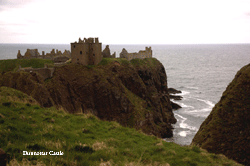
Moving on up the coast, we stopped at Dunnotter Castle, a dramatic and
evocative ruined cliff top fortress. “William Wallace, Mary Queen
of Scots, the Marquis of Montrose and the future King Charles II, all
graced the Castle with their presence. Most famously though, it was at
Dunnottar Castle that a small garrison held out against the might of Cromwell’s
army for eight months and saved the Scottish Crown Jewels, the ‘Honours
of Scotland’, from destruction.”
Now windy and rainy, we stopped for the night in Stonehaven (home of the
deep fried Mars bar) at the Royal Hotel with supper of Scottish pork roast
---
30/4
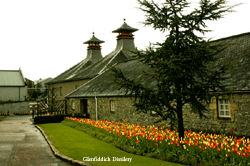 Grey
skies! Grey rain! Grey Aberdeen! So it was on to Duffton in the heart
of Speyside with hopes that the weather would change. And by the time
we reached the Glenfiddich (meaning ‘Valley of the Deer’ in
Gaelic) distillery for a tasting (we found that we could bypass the tour
and get straight to the tasting) it had calmed and cleared up. I, having
“cut my Scotch teeth” on Glenfiddich and "moved on”
years ago, was surprised pleasantly by how smooth and enjoyable the 17
year old was.
Grey
skies! Grey rain! Grey Aberdeen! So it was on to Duffton in the heart
of Speyside with hopes that the weather would change. And by the time
we reached the Glenfiddich (meaning ‘Valley of the Deer’ in
Gaelic) distillery for a tasting (we found that we could bypass the tour
and get straight to the tasting) it had calmed and cleared up. I, having
“cut my Scotch teeth” on Glenfiddich and "moved on”
years ago, was surprised pleasantly by how smooth and enjoyable the 17
year old was.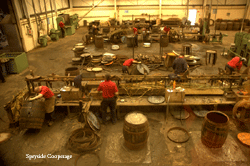
After lunch in Aberlour and a brief stop at Aberlour Distillery (now owned
by Chivas Brother), we landed at Speyside Cooperage to watch men repairing
wooden casks by disassembling them, replacing damages staves and then
reassembling - all by hand. Then it was on to grey Elgin which had little
to nothing to offer except a B&B (the Croft) and an Italian restaurant,
Toscanna, for a baked tagliatelle.
Suffering from greyness,
we decided to visit a few local distilleries the next morning and then
headed south and west.
---
01/5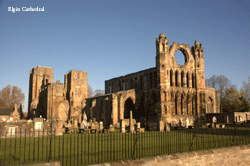
The next morning, surprisingly we woke to sun and walked to Elgin Cathedral,
 a
magnificent ruin, much of which dates back to the 13th century. But sticking
to our revised plan we headed off to Glen Moray, distillery owned by Glenmorangie
http://www.glenmoray.com/index-2.html for a tasting of a 17 year old single
cask (55% strength) and a dram of Classic, described as tasting of 'Shortbread,
butterscotch and lemongrass.'
a
magnificent ruin, much of which dates back to the 13th century. But sticking
to our revised plan we headed off to Glen Moray, distillery owned by Glenmorangie
http://www.glenmoray.com/index-2.html for a tasting of a 17 year old single
cask (55% strength) and a dram of Classic, described as tasting of 'Shortbread,
butterscotch and lemongrass.'
Next was Benromach, Speyside’s smallest distillery located on the
outskirts of the ancient market town of Forres. It has had an open-again/closed-again
history since it was founded in 1898. Most recently, it was purchased
and re-opened in 1998 by Gordon and McPhail. Now just two experienced
distillers are needed to hand-craft Benromach with the spring water from
the nearby Romach Hills.
Then it was off towards Oban, driving along the slithering shoreline of
Loch Ness with a lunch
in Invermoriston, a small village 7 miles north of Fort Augustus, of portabello
and goat cheese.
 Past
Ben Nevis, was Oban,
a picturesque coastal fishing port which was to be our overnight stop
and from which we were to take our car on the ferry to Islay. But next
morning we learned our first Scottish phrase- “noekendu.”
when I tried to book the ferry. After several polite goes at the phrase
I realized that the ferry was full and we changed plans and drove to Kennacraig
where we parked the car, arranged for another rental car to be waiting
for us at the docks at Port Askaig and took the ferry as walk-ons.
McCaig Tower overlooking
Oban
Past
Ben Nevis, was Oban,
a picturesque coastal fishing port which was to be our overnight stop
and from which we were to take our car on the ferry to Islay. But next
morning we learned our first Scottish phrase- “noekendu.”
when I tried to book the ferry. After several polite goes at the phrase
I realized that the ferry was full and we changed plans and drove to Kennacraig
where we parked the car, arranged for another rental car to be waiting
for us at the docks at Port Askaig and took the ferry as walk-ons.
McCaig Tower overlooking
Oban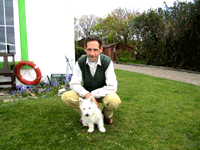
Islay, "The
Queen of the Hebrides,” is the southernmost island of the Inner
Hebrides of Scotland and is famous for its peated scotch, which drew us
to it. After several attempts to find accommodation, we came across the
Anchorage in Bruichladdich; a great place with a character called John,
former deckie on ships, as the owner. The rest of the day was enjoyed
exploring the island from Bowmore, for lunch, to Gruinart and Kilkoman
with dinner in Port Charlotte of bacon and brie salad and seafood casserole.
---
03/05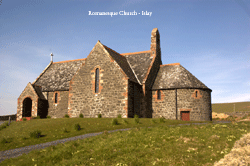
Talking and smoking outside the next morning, John suggested that we “just
get lost” on the island.
First came a Romanesque church that we saw along the road.
 Then
it was up a two track lane until it ended in a bog at which point we left
the car in the middle of the road and hiked to one of many ruins in the
fields.
Then
it was up a two track lane until it ended in a bog at which point we left
the car in the middle of the road and hiked to one of many ruins in the
fields.
Scotch called us so off we went to Ardbeg for tour and tasting of their
new whisky – Alligator, a stop at Lagavulin and lunch at the Lochside
hotel in Bowmore. Kildaton
High Cross Islay people can be unusual as we found when we
visited the woolen mill. The owner told his worker to give us a tour at
which point he gestured to the weaving machine and said through a jumble
of teeth: “this is where we do it” or something akin to that,
and walked away.
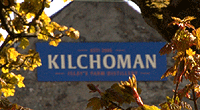 We
wanted to try something new so it was off to Kilchoman (pronounced kilhoman)
which is a new distillery established in 2005 and can barely call the
spirit ‘whisky’. It is the first to be built on Islay for
124 years. What caught our interest is that it carries out traditional
floor maltings with barley that is grown on the farm, whereas other distilleries
purchase barley from around the country. It is fairly good but expensive
given the age.
We
wanted to try something new so it was off to Kilchoman (pronounced kilhoman)
which is a new distillery established in 2005 and can barely call the
spirit ‘whisky’. It is the first to be built on Islay for
124 years. What caught our interest is that it carries out traditional
floor maltings with barley that is grown on the farm, whereas other distilleries
purchase barley from around the country. It is fairly good but expensive
given the age.

Then back to the tried and true at Bruichladdich for a tasting of their
20 year old El Classico and Infinity, followed by pub supper of pheasant
and steak.
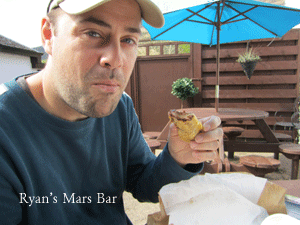 04/05
04/05
The morning cloud cleared for our ferry ride back and for the drive to
Edinburgh. Ryan wanted one more order of fish and chips from a roadside
stand so we stopped at Arronchar where he also got his deep-fried Mars
bar while I enjoyed my last serving of deep fried haggis. Having settled
into our modest room at the airport, we headed into the city where I bought
a second (clay) pipe and we had supper of ribs in Grassmarket.
---
05/05
Our very early Flybe flight took us to Southhampton and then Guernsey
where the weather was miserable - rain and wind – giving Ryan a
lousy introduction to St. Peters Port (SPP.) This was only relieved by
a super dinner at Le Nautique, one of my favourite restaurants on the
Esplanade – liver and blood pudding, and squid stuffed with crab,
and a good Bordeaux wine. Then to bed at St. George’s Hotel.
---
06/05
On Sunday we woke to bright sunshine and headed off to the service in
the Town Church - a beautiful building and a good choir. This is the church
my great-great-grandparents were married in in 1840. We spoke to the rector
for some time after before setting off for La Valette Underground Military
Museum situated in tunnels dug to hide German fuel tanks.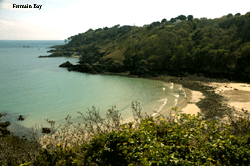
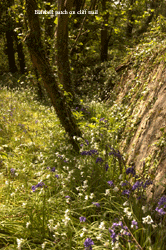
There is a coastal path all the way around the island and we decided to
walk along it to Fermain Bay where we stopped for lunch at the Beach Café.
St. Martins is just above the cliffs so we walked up to
the old family
church and cemetery then on to Bellieuse Farm, birthpace of my grandfather
in 1880,
(see more) where we met Tony, the current owner.
After a day of walking we were ready for dinner at Mora Restaurant with
fresh oysters and fried grill of sea bass, brill, scallops and prawns.
---
07/05
Monday was a Bank Holiday and all the shops and offices were closed so
we arranged for a tour of Hauteville House, a large white building with
a garden overlooking the sea, the home of Victor Hugo during his exile
in Guernsery and where he wrote such books as Les Miserable, Les chansons
des rues et des bois (‘The Songs of the Streets and Woods’)
and Les Travailleurs de la mer (‘Toilers of the Sea’). It
is extremely odd in its decoration and furnishing with a profusion of
chests, sideboards, carpets, mirrors, crockery, figurines and other objects
from his excursions around the island. Hugo lived in Hauteville House
until 1870 when he returned to Paris.
 RACE
DAY MONDAY 7TH MAY - L’ANCRESSE read the signs so it was off to
the races after lunch. L'ancresse Racecourse is the annual flat race meeting
around and through the Island's premier golf course. We
bet 10 pounds (2 per race) and won 19 – not bad for novice betters.
RACE
DAY MONDAY 7TH MAY - L’ANCRESSE read the signs so it was off to
the races after lunch. L'ancresse Racecourse is the annual flat race meeting
around and through the Island's premier golf course. We
bet 10 pounds (2 per race) and won 19 – not bad for novice betters.
Then it was supper at Da Nello of oysters and spaghetti
with squid.
---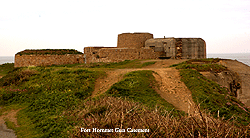
08/05
Tuesday was a comfortable mix of sun and cloud so we bussed to Vazon Bay
and walked around Fort Hommet and gun casements, a combination of installments
from Napoleonic and German times. Then we walk along the coast to Rockmount
Hotel on Cobo Bay for goujons of plaice and a pint of bitters.
Back in SPP we toured of Castle Cornet, Guernsey's ancient harbour fortress,
which was isolated upon a rocky islet off the shores of SPP until the
construction of a breakwater and bridge in the 19th century.
In the evening we went to a talk on Resistance in Guernsey during
the Occupation: Resistance And Its Impact During The Occupation given
by Dr Gillian Carr, Lecturer at the University of Cambridge and Fellow
of St. Catharine's College, who “is pioneering the new concept of
'Occupation Archaeology' using the German occupation of the Channel Islands
as her case study.” Carr and many of those attending the talk seemed
eager (perhaps too eager) to credit resistance in the island population
during the German Occupation of the Channel Islands from the summer of
1940 to 9 May 1945. The Channel Islands were the only part of the British
Isles to be invaded and occupied by German forces during the war.
After a 45 minute walk back in the fresh darkness of the town roads, we
enjoyed a late supper at the Crow’s Nest of fish soup and steak
tartar.
---
09/5
Wednesday was "Liberation Day," the 67th anniversary of the
Liberation of Guernsey from the occupying German forces. It began with
a military parade and inspection – including 11 Ghurkhas, 12 Royal
Hospital Chelsea-in-Pensioners (unmistakeable in their Scarlet Coats)
and the Royal Observer Corp Standard,
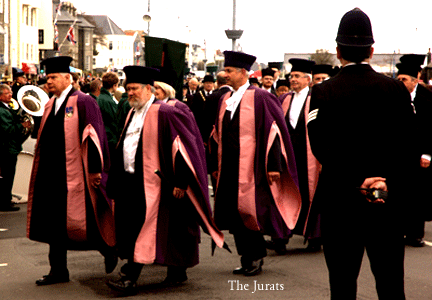
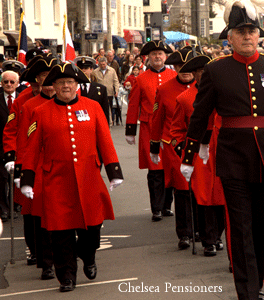
followed by a very moving church service of remembrance of all of those
who suffered from the occupation which was broadcasted on a jumbo screen.
Then the event was handed over to children on verious rides, adults playing
'Croan and Anchor,' and a singer doing a very amusing impersonation of
Michael Jackson.
We decided to have a final walk through town to Candie Cemetery on the
hill overlooking the port to visit the tombstone of my great-great-grandmother
Margerite (LePage) Loney before our last supper at Le Nautique of oysters
and monkfish.
---
10/05
Guernsey can be foggy and, with our luck, our flight to Gatwick was “delayed
indefinitely” due to weather. Finally it got away 1 ½ hours
late but fortunately my Air Transat was also delayed and, with some effort,
I made the plane home and Ryan took off to Heathrow to get his flight
to Bangkok.
78 Mountain Ave, Hamilton, Ontario, Canada L8P4G2
All text and images are copyrighted. Any use is by permission only.
Site is under construction. Last update: July 11, 2012
